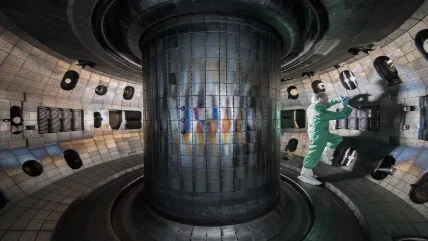
China’s new-generation tokamak, Huanliu-3 (HL-3), has made significant progress operating in high-confinement mode (H mode) under a plasma current of 1 million amperes for the first time, China National Nuclear Corporation (CNNC) announced. The experiment took place at CNNC’s Southwestern Institute of Physics (SWIP) in Chengdu, Sichuan Province. It is not clear whether this refers to the HL-2M tokamak, which was commissioned at SWIP in December 2020 as an upgrade of the earlier the HL-2A or whether this is a further upgrade.
CNNC said the recent achievement “once again broke the operation record of China’s nuclear fusion devices based on magnetic confinement, overcoming many technical challenges”. It added: “This milestone holds great importance in China’s nuclear fusion energy development, signifying a crucial step forward in the research of high-performance nuclear fusion plasma operation.
H mode is an advanced operating mode that has been chosen as the standard operating mode for the International Thermonuclear Experimental Reactor (ITER) which is currently under construction at Cadarache in France. It enhances the overall confinement of plasma, improves the economic efficiency of the reactor, and can increase the comprehensive plasma parameters by several times compared with ordinary modes. ITER is a first-of-a-kind global collaboration to construct the world’s largest tokamak based on magnetic confinement technology. It is funded mainly by the European Union (45.6%) with the remainder shared equally by China, India, Japan, Korea, Russia and the USA (9.1% each).
Zhong Wulyu, director of the Centre of Fusion Science at SWIP, told China Media Group (CMG) that “the Huanliu-3 team will further study frontier fusion plasma physics, laying a solid foundation for China to carry out burning plasma experiment and build fusion reactors.”
SWIP was established in 1965, and was China’s first nuclear fusion research institute. Over the past 50 years, SWIP has built more than 20 experimental devices for controlled nuclear fusion research. These included two medium-sized tokamaks in 1984 and 1994 (HL-1 and HL-1M). In 2002, SWIP constructed the first tokamak with divertor configuration in China, HL-2A, which achieved a number of breakthroughs. The upgraded HL-2M with an advanced divertor, is designed to have 3MA plasma current, and over 150 million degrees Celsius ion temperature.
SWIP has played a key role in ITER’s construction, and has been contributing to the research and development of ITER’s magnet supports; shielding blanket and first wall; glow discharge cleaning system and gas injection system; neutron flux monitor and divertor Langmuir probe; as well as the design and development of key technologies for the ITER helium cooled solid test blanket module.
HL-2M will continue to provide technical support for China’s participation in ITER.
HL-2M is one of three major domestic tokamaks now in operation in China. The other two are the Experimental Advanced Superconducting Tokamak (EAST) machine at the Institutes of Physical Science, Chinese Academy of Sciences (ASIPP) in Hefei and J-TEXT at the Huazhong University of Science and Technology (HUST).
These have all paved the way for the China Fusion Engineering Testing Reactor (CFETR), the preliminary conceptual design of which was finished in 2015 and engineering design started in 2017. CFETR is intended for steady-state operation, as well as tritium self-sustainment. In phase one it should have 200MW fusion power and in phase two it should have power of 1GW. It aims to bridge the fusion experiments between ITER and DEMO – the proposed nuclear fusion power station expected to build upon ITER. DEMO is seen as the next step towards a “first of a kind” commercial station. CFETR aims to provide DEMO validation.
Image: China’s HL-2M tokamak (courtesy of CNNC)


